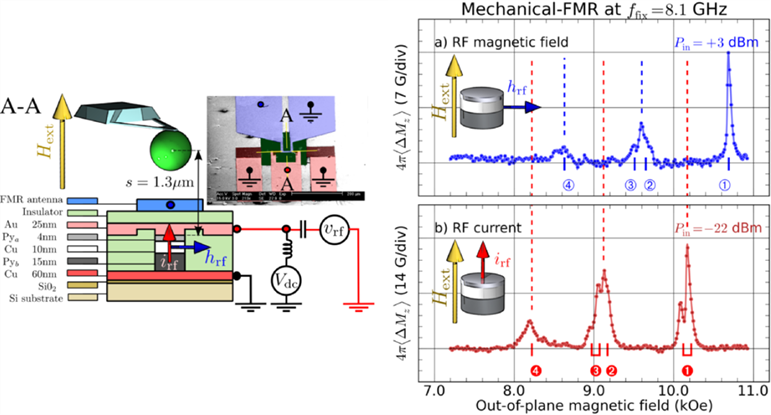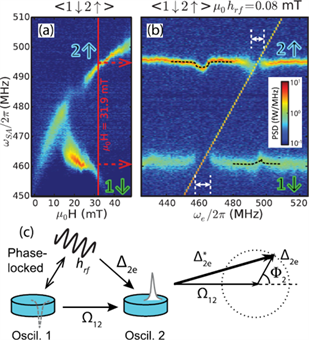Nanomagnetism & Oxides Laboratory
Spin-Transfer NanoOscillators
People: G. de Loubens (Permanent staff)
Alumni: Abbass Hamadeh (PhD), Xavier de Milly (PhD), Yi Li (PostDoc)
Collaborations: Unité Mixte de Physique CNRS/Thales, SPINTEC
Fundings: FP7 MASTER (2008-2012) et MOSAIC (2013-2016), ANR SPINNOVA (2012-2015) MEMOS (2014-2018)
Alumni: Abbass Hamadeh (PhD), Xavier de Milly (PhD), Yi Li (PostDoc)
Collaborations: Unité Mixte de Physique CNRS/Thales, SPINTEC
Fundings: FP7 MASTER (2008-2012) et MOSAIC (2013-2016), ANR SPINNOVA (2012-2015) MEMOS (2014-2018)
Spin torque nano-oscillators (STNOs) are spintronic devices capable of generating a tunable oscillation voltage in the microwave range while being biased by a dc current. They are based on two reciprocal physical phenomena, the spin transfer and magnetoresistive effects. Their microwave properties are directly related to the magnetization dynamics excited in the heterostructure and to its magnetoresistance properties. A striking feature of such devices compared to other oscillators is their strong nonlinear properties, that are inherited from the equation of motion of magnetization. From a fundamental point of view, this makes them a very unique platform to study highly nonlinear oscillators, which are seldom in nature. From a practical point of view, this yields very interesting and attractive properties for applications. In particular, the emission frequency of spin torque oscillators is highly tunable. Moreover, these large nonlinearities make STNOs very sensitive to external stimuli. This has advantages, because STNOs can easily adapt their auto-oscillation frequency to phase-lock to an external signal, or synchronize to other oscillators. But this has also drawbacks, as their sensitivity to noise is exacerbated by the nonlinear phase-amplitude coupling.

Fig.1. Comparative spin-wave spectroscopy of a spin-valve nanopillar. Schematic representation of the experimental setup and sample design. The inset is a microscopy image of the two independent excitation circuits: in blue the circuit allowing the generation of an rf in-plane magnetic field; in red the circuit allowing the injection of an rf current perpendicular-to-plane through the nano-pillar. The corresponding experimental spin-wave spectra at 8.1~GHz are presented in (a) and (b), respectively.
From these general considerations, is is clear that the spectroscopic study of heterostructures is crucial to understand and improve STNOs characteristics. As a matter of fact, these are the energy, relaxation and nonlinear properties of STNOs spin-wave eigenmodes that determine their emission frequency and their spectral purity. Moreover, their spatial symmetries impose their selection rules and indicate which coupling mechanisms can be at play intra- or inter-STNOs. Using MRFM spectroscopy, we can identify the spin-wave eigenmodes and their selection rules in an STNO by MRFM spectroscopy (cf. Fig.1) [1]. By quantitatively monitoring its emitted power we also unambiguously identify the first spin-wave mode to auto-oscillate in the autonomous regime, while driven by spin transfer torque [2].
By means of high frequency transport techniques, we also study the same STNO in a configuration where a magnetic vortex is stabilized in both magnetic layers. We detect a highly coherent auto-oscillating mode, which corresponds to the coupled dynamics of the thick and thin vortex-state layers [3]. We also reveal the influence of damped spin-wave modes on the spectral purity of the spin-transfer-driven dynamics in this system [4]. Moreover, we demonstrate that the latter is very efficiently synchronized to a weak external microwave field, since perfect phase-locking is observed [5].
By means of high frequency transport techniques, we also study the same STNO in a configuration where a magnetic vortex is stabilized in both magnetic layers. We detect a highly coherent auto-oscillating mode, which corresponds to the coupled dynamics of the thick and thin vortex-state layers [3]. We also reveal the influence of damped spin-wave modes on the spectral purity of the spin-transfer-driven dynamics in this system [4]. Moreover, we demonstrate that the latter is very efficiently synchronized to a weak external microwave field, since perfect phase-locking is observed [5].

Fig.2. Probing the dipolar coupling between two vortex-based STNOs with an external source. (a) Power spectral density maps of auto-oscillations in the opposite polarity state, for which mutual synchronization is observed between µ0H=17.5 and 26.0 mT. (b) Auto-oscillation spectra as a function of microwave field frequency for µ0H=31.9 mT, in the unsynchronized state. The signal from the source appears as the oblique narrow line. White arrows show the phase-locking bandwidths of oscillators 1 and 2 to the external source. Black dashed curves are fits to the analytical theory based on the vector diagram shown in (c), displayed when oscillator 1 is phase-locked to the microwave field.
The possibility of mutual synchronization of STNOs is very interesting. Our idea here is to replace the external microwave field by the dipolar stray field of an adjacent STNO. We performed an original MRFM spectroscopic measurement of the dynamical dipolar coupling in adjacent nanomagnets [6]. We then perform the study of mutual synchronization on pairs of STNOs in the vortex state, and demonstrate that the strength of the dipolar interaction is controlled by the relative alignment of vortex polarities in each STNO [7]. Finally, we go one step further and introduce an external source in the game (cf. Fig.2), which can be considered as a third reference oscillator and enables to determine the strength and phase shift of the dipolar coupling between the two STNOs [8].
References:
[1] V. V. Naletov, G. de Loubens, G. Albuquerque, S. Borlenghi, V. Cros, G. Faini, J. Grollier, H. Hurdequint, N. Locatelli, B. Pigeau, A. N. Slavin, V. S. Tiberkevich, C. Ulysse, T. Valet, and O. Klein, Identification and selection rules of the spin-wave eigenmodes in a normally magnetized nanopillar, Phys. Rev. B 84, 224423 (2011).
[2] A. Hamadeh, G. de Loubens, V. V. Naletov, J. Grollier, C. Ulysse, V. Cros, O. Klein, Autonomous and forced dynamics in a spin-transfer nano-oscillator: Quantitative magnetic-resonance force microscopy, Phys. Rev. B 85, 140408(R) (2012).
[3] N. Locatelli, V. V. Naletov, J. Grollier, G. de Loubens, V. Cros, C. Deranlot, C. Ulysse, G. Faini, O. Klein, A. Fert, Dynamics of two coupled vortices in a spin valve nanopillar excited by spin transfer torque, Appl. Phys. Lett. 98, 062501 (2011).
[4] A. Hamadeh, N. Locatelli, V. V. Naletov, R. Lebrun, G. de Loubens, J. Grollier, O. Klein, V. Cros, Origin of spectral purity and tuning sensitivity in a vortex-based spin transfer nano-oscillator, Phys. Rev. Lett. 112, 257201 (2014).
[5] A. Hamadeh, N. Locatelli, V. V. Naletov, R. Lebrun, G. de Loubens, J. Grollier, O. Klein, V. Cros, Perfect and robust phase-locking of a spin transfer vortex nano-oscillator to an external microwave source, Appl. Phys. Lett. 104, 022408 (2014).
[6] B. Pigeau, C. Hahn, G. de Loubens, V. V. Naletov, O. Klein, K. Mitsuzuka, D. Lacour, M. Hehn, S. Andrieu, F. Montaigne, Measurement of the Dynamical Dipolar Coupling in a Pair of Magnetic Nanodisks Using a Ferromagnetic Resonance Force Microscope, Phys. Rev. Lett. 109, 247602 (2012).
[7] N. Locatelli, A. Hamadeh, F. Abreu Araujo, A. D. Belanovsky, P. N. Skirdkov, R. Lebrun, V. V. Naletov, K. A. Zvezdin, M. Muñoz, J. Grollier, O. Klein, V. Cros, G. de Loubens, Efficient Synchronization of Dipolarly Coupled Vortex-Based Spin Transfer Nano-Oscillators, Sci. Rep. 5, 17039 (2015).
[8] Y. Li, X. de Milly, F. Abreu Araujo, O. Klein, V. Cros, J. Grollier, G. de Loubens, Probing Phase Coupling Between Two Spin-Torque Nano-Oscillators with an External Source, Phys. Rev. Lett. 118, 247202 (2017).
[2] A. Hamadeh, G. de Loubens, V. V. Naletov, J. Grollier, C. Ulysse, V. Cros, O. Klein, Autonomous and forced dynamics in a spin-transfer nano-oscillator: Quantitative magnetic-resonance force microscopy, Phys. Rev. B 85, 140408(R) (2012).
[3] N. Locatelli, V. V. Naletov, J. Grollier, G. de Loubens, V. Cros, C. Deranlot, C. Ulysse, G. Faini, O. Klein, A. Fert, Dynamics of two coupled vortices in a spin valve nanopillar excited by spin transfer torque, Appl. Phys. Lett. 98, 062501 (2011).
[4] A. Hamadeh, N. Locatelli, V. V. Naletov, R. Lebrun, G. de Loubens, J. Grollier, O. Klein, V. Cros, Origin of spectral purity and tuning sensitivity in a vortex-based spin transfer nano-oscillator, Phys. Rev. Lett. 112, 257201 (2014).
[5] A. Hamadeh, N. Locatelli, V. V. Naletov, R. Lebrun, G. de Loubens, J. Grollier, O. Klein, V. Cros, Perfect and robust phase-locking of a spin transfer vortex nano-oscillator to an external microwave source, Appl. Phys. Lett. 104, 022408 (2014).
[6] B. Pigeau, C. Hahn, G. de Loubens, V. V. Naletov, O. Klein, K. Mitsuzuka, D. Lacour, M. Hehn, S. Andrieu, F. Montaigne, Measurement of the Dynamical Dipolar Coupling in a Pair of Magnetic Nanodisks Using a Ferromagnetic Resonance Force Microscope, Phys. Rev. Lett. 109, 247602 (2012).
[7] N. Locatelli, A. Hamadeh, F. Abreu Araujo, A. D. Belanovsky, P. N. Skirdkov, R. Lebrun, V. V. Naletov, K. A. Zvezdin, M. Muñoz, J. Grollier, O. Klein, V. Cros, G. de Loubens, Efficient Synchronization of Dipolarly Coupled Vortex-Based Spin Transfer Nano-Oscillators, Sci. Rep. 5, 17039 (2015).
[8] Y. Li, X. de Milly, F. Abreu Araujo, O. Klein, V. Cros, J. Grollier, G. de Loubens, Probing Phase Coupling Between Two Spin-Torque Nano-Oscillators with an External Source, Phys. Rev. Lett. 118, 247202 (2017).